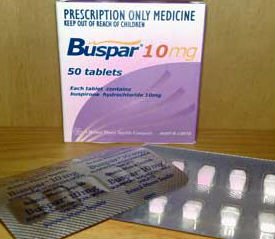Buspar against anxiety
 Mental problems are currently one of the leading medical and social problems. Their prevalence in the population is extremely high 10-20% of the total population in developed countries, with an average annual growth rate in the world exceeding 10%. Therefore, the problem of effective diagnosis and therapy of neurotic disorders goes today to one of the first places in medicine and pharmacology.
Mental problems are currently one of the leading medical and social problems. Their prevalence in the population is extremely high 10-20% of the total population in developed countries, with an average annual growth rate in the world exceeding 10%. Therefore, the problem of effective diagnosis and therapy of neurotic disorders goes today to one of the first places in medicine and pharmacology.
One of the most characteristic clinical manifestations of neuroses, as well as psychoemotional disorders within the framework of psychosomatics is anxiety disorder. That is why professionals appoint medications to reduce and completely eliminate such problems. Buspar medication differs in its chemical structure from all other previously known anxiolytics and belongs to the class of azaspirones.
It occupies a special place among all neuropharmacological agents and can be considered as a drug combining the properties of anxiolytics and antidepressant. Such a profile of pharmacological activity is determined by a kind of complex mechanism of action of Buspar. It has unique properties of a pharmacological "corrector" for serotonergic mediation. At the same time, with panic attacks, the effectiveness of Buspar therapy remains in doubt. The available data either do not confirm it, or indicate a slightly pronounced effect. Of undoubted interest is the possibility of using drug in patients with neuroses on the background of various psychosomatic symptoms. As is known, anxiety and anxiety-depressive syndromes are practically obligate components of various clinical forms of neuroses, and also very often accompany the most important forms of psychosomatic pathology-coronary heart disease, hypertension, neurocirculatory dystonia, irritable colon syndrome, etc. Therefore, the possibility of a one-stage implementation with the help of a single drug is very attractive and deserving attention.
Within the 3-week comparative study of Buspar (10-20 mg day) and Lorazepam in a combined anxiety-depressive syndrome with cardioneurosis, both drugs were equally effective in eliminating the disturbing manifestations of the syndrome. But Buspar, in contrast to Lorazepam, proved to be an effective tool for influencing and depressive symptoms. In this case, Buspar treatment was better tolerated, and in the long-term (4-year) follow-up period, only 38% of patients receiving this drug had the need for subsequent benzodiazepines; Among the patients receiving Lorazepam in 64%. These data are very important in assessing the long-term effectiveness of therapy. It can be assumed that even are latively short (3-week) course of treatment with this drug causes a deep restructuring of regulatory centers and inter-neuronal interrelations (primarily in the mesolimbic and mesocortical systems), which contributes to the long-term stabilization of the neurotransmitter balance.
Another noteworthy aspect of the use of Buspar is its use for stress-induced anxiety, that is, outside the specific nosological form, in general medical practice. At a 3-week course in a dose of 20-25 mg day proved to be an effective means of eliminating anxiety symptoms in this category of persons with good tolerability of treatment. Another area of application of drug Buspar in clinical practice are depressive and obsessive-compulsive disorders. It should immediately be emphasized that medication does not have an independent clinical value as an antidepressant. At the same time, this drug proved to be an important tool for increasing the effectiveness of antidepressant therapy with SSRIs in cases of resistant depressions of both psychotic and reactive genesis. Similar data were obtained with the addition to SSRIs in therapy resistant forms of OCD. Thus, Buspar is a fundamentally new tool in neuropharmacology. Although its mechanisms of action and clinical capabilities are not yet fully disclosed, the potential looks very promising.
An important condition for achieving compliance with therapy is awareness of the timing of the onset of its clinical effect. It should be remembered that the first manifestations of Buspar activity are noted only at the 2-3rd week of therapy, which is associated with a polycomponent rearrangement of the receptor apparatus in the CNS and the achievement of the neurotransmitter balance. Therefore, in this situation, the doctor and patient are ready for longer therapy to achieve the desired result.
The leading criterion for the desirability of prescribing drug in clinical practice is, along with efficacy, and safety. According to instruction Buspar belongs to quite safe neurotropic drugs. Among its most common undesirable effects are drowsiness, headache, dizziness, excitement, that is, the safety profile of this drug is significantly more favorable than SSRIs. The drug also does not have a negative effect on cognitive functions and sexuality, does not cause the development of serotonin syndrome, does not increase convulsive brain readiness. Buspar also has a low potential for inter-drug interaction, which allows it to be widely used together with other neuro- and psychotropic and somatotropic agents.